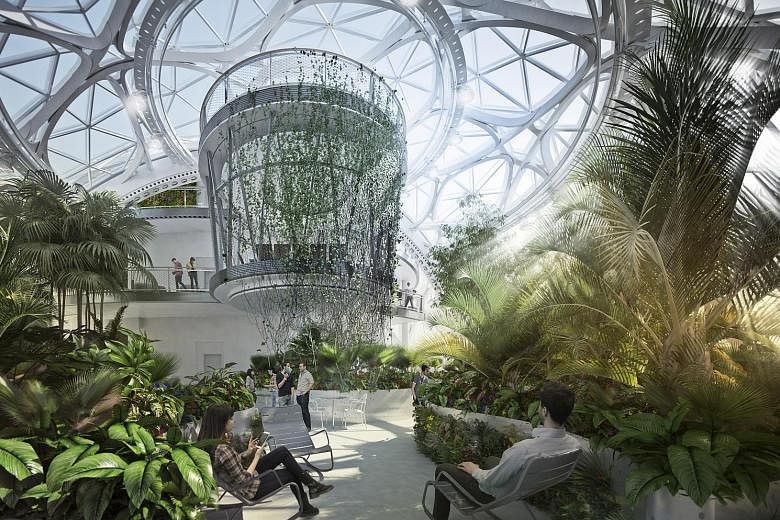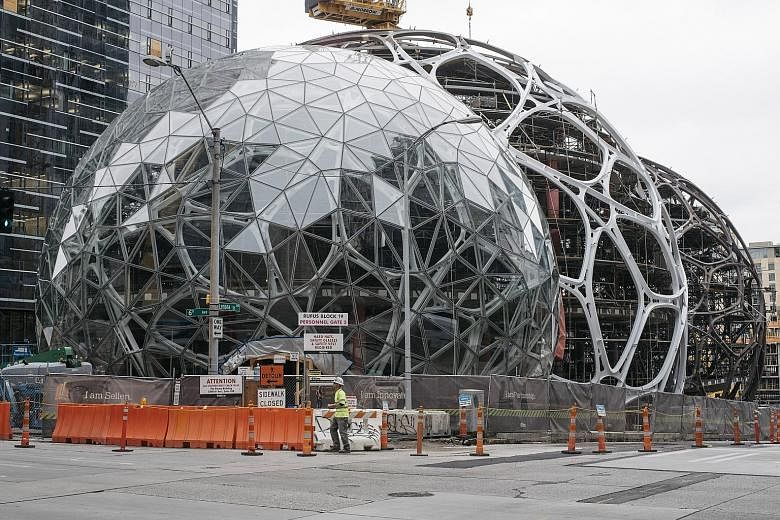REDMOND, WASHINGTON • Just off a remote stretch of road here, near wineries, stables and farms, Amazon is secretly growing something, but it is not what Mr Jeff Bezos, Amazon's chief executive, calls the "tiny seeds" that could become the company's next big businesses.
No, Amazon is growing actual plants, more than 3,000 species of them spread around a 0.4ha greenhouse a half-hour's drive from Amazon's headquarters in Seattle. There are carnivorous pitcher plants, exotic philodendrons and orchids from Ecuador that resemble the menacing flora from the 1986 movie Little Shop Of Horrors.
"Cinnamon, wax candy and baby powder," said Mr Ron Gagliardo, the Amazon horticulturist who oversees the greenhouse, when asked to describe the mysterious scent of the orchid, called Anguloa virginalis.
Amazon pioneered Internet shopping, electronic book reading and cloud computing.
Now, as it enters adulthood, it is applying some of that inventiveness to its new home.
It is constructing a collection of high- and low-rise buildings in downtown Seattle that will be arrayed around three striking transparent, conjoined structures that it calls spheres. They will act as high-tech greenhouses, the kind of flashy architecture that Amazon shunned for the first 22 years of its life.
Mr John Schoettler, director of Amazon's global real estate and facilities, said: "We wanted it to be iconic, a structure that would be similar to another icon in the city, like the Space Needle, for newcomers to Seattle. It would be a found treasure in the downtown neighbourhood."
The real point of the spheres is how Amazon wants to use the nature on the inside to inspire employees.
When the spheres open in early 2018, they will be packed with a plant collection worthy of top-notch conservatories, letting employees amble through tree canopies three storeys off the ground, meet colleagues in rooms with walls made from vines and eat kale Caesar salads next to an indoor creek.
Since Amazon decided about a decade ago to stay in downtown Seattle, the company said, it has invested more than US$4 billion (S$5.4 billion) in the construction and development of offices in the city, though it will not disclose the budget for the spheres. The spheres will be accessible only to Amazon employees, but the company could allow public tours.
"The idea was to get people to think more creatively, maybe come up with a new idea they wouldn't have if they were just in their office," said Mr Dale Alberda, lead architect on the project at NBBJ, a firm that has also worked on building projects for Samsung, Google and Chinese Internet company Tencent.
Tech companies have been eager to test ways to make workplaces more conducive to creativity. Some turn their offices into grown-up playgrounds, with beanbag chairs, ball pits and ping-pong tables.
The more refined alternative now catching on is to make nature the star of the show.
Apple, for example, has hired arborist Dave Muffly to oversee the planting of about 8,000 trees on its new 71ha campus in Cupertino, California, which will surround a spaceship-shaped new building where Apple employees will work. The mostly native trees are intended to restore the natural landscape that once blanketed Silicon Valley.
What makes Amazon's project unusual is its location - in the heart of a city rather than on a sprawling suburban campus of the sort favoured by most big tech companies.
Amazon, the largest private employer in Seattle, has more than 20,000 employees spread out in more than 30 buildings in the city. Its current construction plans will give it the space to more than double its local headcount.
Mr Bezos has said Amazon is staying put in a city because the kinds of employees it wants are attracted to an urban environment. But the concrete and steel canyons around Amazon's new downtown properties do not have a lot of greenery.
That is where the spheres and Mr Gagliardo, whom Amazon hired to fill them with plants, enter the picture.
The spheres will have meeting areas called treehouses and suspension bridges that will be just wobbly enough to quicken the pulses of employees who walk over them.
"Amazon said, 'Make this fun'," said Mr Alberda.
During the day, the spheres will be kept at about 22 deg C and 60 per cent humidity, while at night, the temperature will average 12 deg C and the humidity 85 per cent, which Mr Gagliardo said would be optimal for the cloud forest plant specimens it has collected.
NEW YORK TIMES


